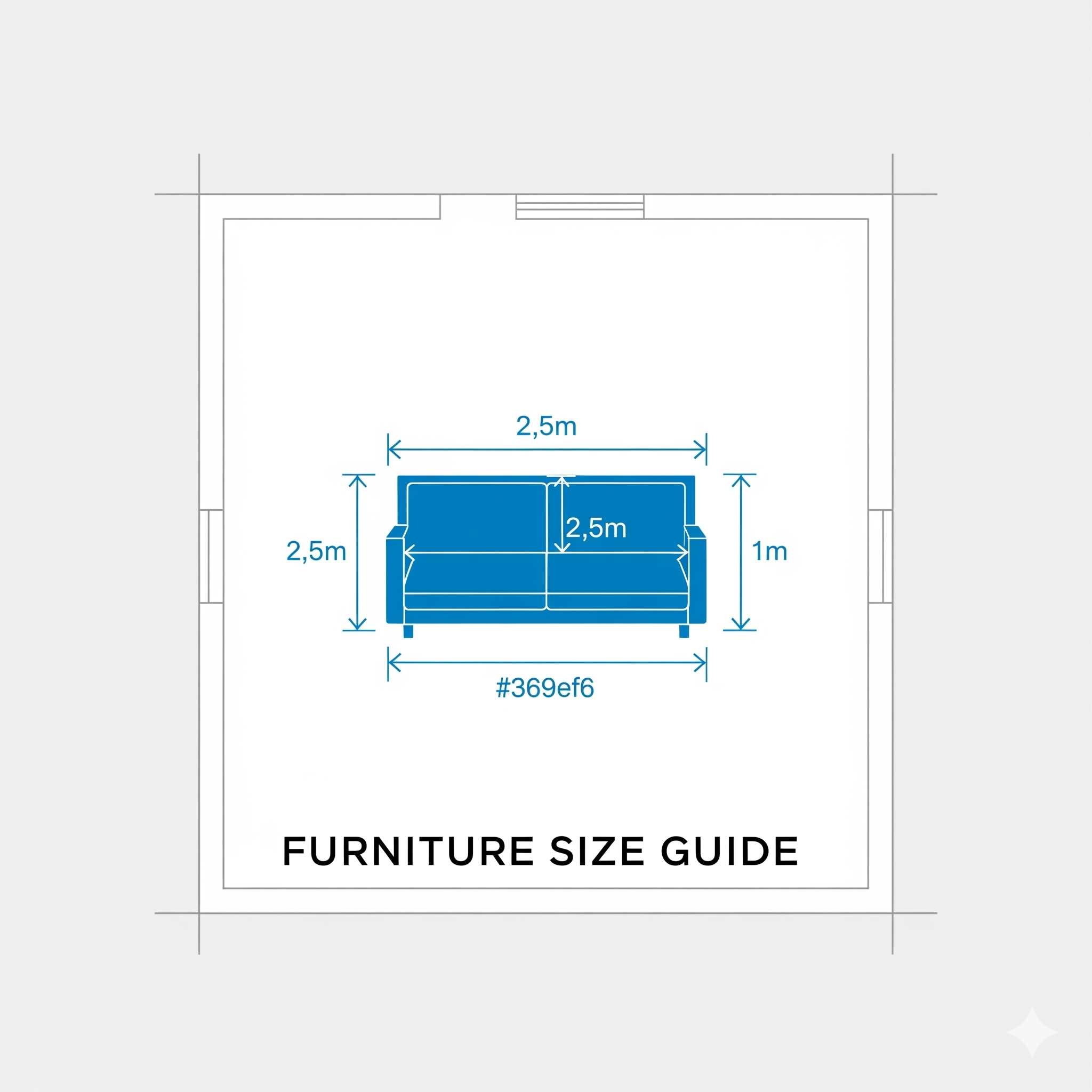Furniture Size Guide & Room Calculator
Our free Furniture Size Guide calculates the ideal dimensions for your sofa, rug, and tables based on your room’s size. Choose perfectly proportioned furniture every time.
Furniture Size Guide
Enter your room’s dimensions, select a furniture type, and get ideal size recommendations based on interior design best practices.
How to use this tool: Enter your room’s width and length in feet. Select the type of furniture you’re shopping for from the dropdown menu, then click the button. The guide will provide you with a recommended size range based on proven interior design principles to ensure your space looks balanced and beautiful.
The Furniture Size Guide: Your Secret Weapon for a Perfectly Proportioned Home
Have you ever fallen in love with a piece of furniture in a vast, open showroom, only to get it home and realize it’s a giant that devours your entire room? It’s a classic and costly mistake. The number one secret of a beautifully designed room isn’t the price of the furniture, but its **scale and proportion**. Getting this right is what creates that effortless, harmonious feeling you see in design magazines. As the founder of Neat Tiny Home, I’ve seen that in a small space, this principle is ten times more important. That’s why I created this **Furniture Size Guide**. It’s a simple tool that takes the complex “rules” of interior design and turns them into a personal cheat sheet, ensuring you can choose furniture with the confidence of a seasoned professional.
Think of this tool as a bridge between your room’s dimensions and your shopping list. It demystifies the questions that plague every decorator: “Is this rug too small?” “Will this sofa overwhelm the space?” “How big can my dining table actually be?” By using proven formulas from the world of interior design, this **Furniture Size Guide** gives you a concrete, data-driven starting point. It empowers you to stop guessing and start designing, ensuring every major piece you bring into your home is not just something you love, but something that is perfectly suited for the space it will inhabit.
Scale vs. Proportion: The Secret Language of a Well-Designed Room
To use this guide effectively, it helps to understand two key terms that designers live by: scale and proportion. **Scale** refers to how the size of an object relates to the room itself. A massive, overstuffed sectional sofa has the wrong scale for a 120-square-foot tiny living room. **Proportion** refers to how the size of an object relates to the other objects in the room. A tiny coffee table in front of a large sofa would be out of proportion. Our **Furniture Size Guide** helps you nail the *scale* of your largest items, which in turn makes it much easier to get the *proportion* of your other decor right. A room where these two elements are in harmony feels calm, balanced, and intentional. A room where they are off feels chaotic and uncomfortable, even if you can’t quite put your finger on why.
A Visual Guide to Essential Layout Clearances
The recommendations in our calculator are based on preserving comfortable “negative space”—the empty areas you need for movement and visual breathing room. Professional designers follow a set of standard clearance measurements to ensure a room is functional, not just beautiful. Keeping these in mind is crucial.
| Clearance Type | Recommended Space | Why It Matters |
|---|---|---|
| Major Walkways | 30 – 36 inches | Allows for comfortable, unobstructed movement through a room. |
| Sofa to Coffee Table | 14 – 18 inches | Close enough to reach your drink, but far enough to move your legs. |
| Rug to Wall | 12 – 24 inches | Creates a pleasing border and makes the room feel larger. |
| Around a Dining Table | Minimum 36 inches | Allows chairs to be pulled out and for people to walk behind them. |
As noted by design authorities like Architectural Digest, these “rules” are the invisible framework that makes a room feel right. Our **Furniture Size Guide** does this math for you, ensuring your choices will work in the real world.
Pro Tips for Furnishing a Tiny Space
Getting the dimensions right is the first and most important step. But to truly master the art of furnishing a tiny space, you can employ a few more visual tricks to enhance the feeling of spaciousness:
- Choose Furniture with Legs: Sofas, chairs, and consoles that are raised on visible legs create a sense of openness because you can see more of the floor. This “leggy” furniture feels visually lighter than heavy, skirted pieces.
- Embrace Multi-Functionality: Look for pieces that do double duty. A storage ottoman can be a coffee table, extra seating, and a place to hide blankets. A drop-leaf table can be a slim console most of the time and a dining table when you need it.
- Go Vertical: Draw the eye upward with tall, narrow bookshelves instead of a wide, low media unit. This emphasizes the room’s height and uses wall space that is often ignored.
- Use Reflective and Transparent Surfaces: A well-placed mirror can visually double the size of a room. Glass or acrylic (lucite) coffee tables and consoles are fantastic for small spaces because they have almost zero visual weight, making them seem to disappear. For inspiration, check out the small space collections at retailers like West Elm.
Your tiny home has the potential to be a stylish, comfortable, and incredibly functional sanctuary. It all starts with choosing the right pieces. Don’t let your next furniture purchase be a game of chance. Use this **Furniture Size Guide** to shop with data, design with principles, and create a space that you will absolutely love to live in.
What is the biggest furniture challenge you’re facing in your home right now? Have you ever bought a piece that was completely the wrong scale? Share your stories and questions in the comments below!
Frequently Asked Questions (FAQ)
- What about the height of my furniture?
Height is crucial for proportion. As a general rule, the arms of your chairs and sofa should be a similar height. The tops of your end tables should be at or just below the height of the arm of the chair or sofa they’re next to. Our calculator focuses on the floor plan (width and length), which is the hardest part to get right. - My room isn’t a perfect rectangle. How do I use the calculator?
For L-shaped or irregularly shaped rooms, break the room down into its main rectangular zones. Use the dimensions of the primary zone where the furniture will be placed (e.g., the main “living room” rectangle) for your calculation. - Is it better to have a few larger pieces or many smaller pieces in a tiny room?
This is a classic design debate. Generally, a few well-chosen, appropriately-scaled larger pieces will make a room feel less cluttered and more serene than many small, “ditsy” pieces. For example, one loveseat is often better than two tiny armchairs. - Do these rules apply to bedrooms?
Yes, the principles are the same! For an area rug in a bedroom, you want it to extend at least 18-24 inches on either side of the bed. For a dresser, ensure it doesn’t block walkways. The core ideas of clearance and proportion are universal.




Post Comment